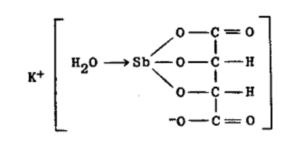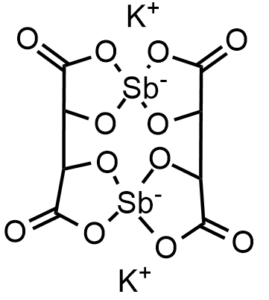
As previously described for Sodium Potassium Tartrate, with Antimony Potassium Tartrate we are facing the same dilemma: what the better option would be, between Natural Racemic or Synthetic product, being the chemical structure the key criterion.
Let us start by defining the RACEMIC product: it is a SYNTHETIC product obtained through the same process described for Sodium Potassium Tartrate. From a regulatory point of view it is considered a different product from Antimony Potassium Tartrate having it a specific Cas number, crystal appearance and a lower apparent density (i.e.on a weight for weight basis it occupies a larger volume).
The Racemic product is usually imported from China.
In our plant we produce Antimony Potassium Tartrate of vine origin. All the special warnings relevant to Sodium Potassium Tartrate are also to be applied to this product without remarking its obviously exclusive technical purposes and unsuitability for human consumption.
The Natural “Synthetic” product (of Chinese origin) seems not to have entered the European market so far. Probably because of the limited quantities consumed, it is not currently being produced.
History

Antimony Potassium Tartrate has long been known with the common name of Emetic Tartrate thanks to its powerful potential to induce vomiting when ingested.

The chemical formula of Antimony Potassium Tartrate has evolved along with the progressing in structural analysis systems; it was originally known with the formula set out in Merck Index 8th edition,1968 and later with the currently worldwide accepted 2- antimony atom formula set out in Merck Index 11th edition,1989.
From a historical perspective ,the fact that the formula has evolved overtime and often been seen as a derivative of various basic structures, has created a problem in terms of defining a Cas number. In fact the Antimony Potassium Tartrate molecule does not have a single Cas number but many.
For information here below the most common Cas numbers used to identify Antimony Potassium Tartrate:
. Number CE 229-436-1 CAS 6535-15-1 antimony (3+)potassium [R-(R*,R*)]-monotartrate
. Trihydrated salt CAS 28300-74-5 dipotassium bis [ [tartrate(4-)O1,O2:O3,O4]] diantimonate(2-),stereoisomer.
. US pharmacopoeia also matches it with Anhydrous Salt, CAS and CE 234-293-3;n.b.: CE number always referred only to anhydrous compounds.
. CAS 64070-12-8 dl Antimony Potassium Tartrate ( Racemic)
. CAS 64070-11-7 d Antimony Potassium Tartrate
Uses
USES OF ANTIMONY POTASSIUM TARTRATE
. Textile dying ( as a mordant for ryon and cotton)
. Leather dying ( as a mordant or fixing agent)
.Zinc industry ( in electrolytic refining of zinc from cobalt and nickel)
. Galvanic industry ( in the coating and burnishing of metal)
. Paint industry ( marine antifouling paint)
. Building, plastic, rubber industry (in flame retardants)
. Ceramic industry ( as a colorant on ceramic surfaces)
. Soluble antimony (necessary in various processes)
Packaging
- 25kg paper sacks
- 50kg fiber drums
- 1000kg pallet in paper sacks
- 900kg pallet in fiber drums
Certificazione
No certification available for this product